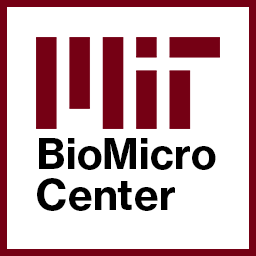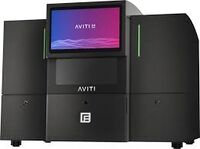BioMicroCenter:Element Sequencing: Difference between revisions
No edit summary |
No edit summary |
||
| Line 1: | Line 1: | ||
== Element Sequencing == | == Element Sequencing == | ||
The Center currently hosts an AVITI24 platform by [https://www.elementbiosciences.com/ Element Biosciences]. Element's AVITI24 platform uses rolling circle amplification with dye-labelled avidites, and is capable of producing more than 1 billion reads per run. The AVITI24 has 4 independent lanes which can be run across a total of 2 flow cells at the same time, with the exception of 2x300 paired-end run kits, which can only run using a single lane per flow cell. Element also | The Center currently hosts an AVITI24 platform by [https://www.elementbiosciences.com/ Element Biosciences]. Element's AVITI24 platform uses rolling circle amplification with dye-labelled avidites, and is capable of producing more than 1 billion reads per run. The AVITI24 has 4 independent lanes which can be run across a total of 2 flow cells at the same time, with the exception of 2x300 paired-end run kits, which can only run using a single lane per flow cell. Element also has Freestyle sequencing kits, with which both Illumina and Element libraries can be sequenced on the platform. Index hopping rates are virtually nil, limiting the need for UDI's. Teton chemistry is also an option with this unit. | ||
=== Workflow === | === Workflow === | ||
Library prep options for [https://openwetware.org/wiki/BioMicroCenter:DNA_LIB DNA] or [https://openwetware.org/wiki/BioMicroCenter:RNA_LIB RNA] are available for Element sequencing. Once Element-ready or Illumina libraries have been submitted, we will verify fragment size via [https://openwetware.org/wiki/BioMicroCenter:QC AATI's Fragment Analyzer] or [https://openwetware.org/wiki/BioMicroCenter:QC Femto Pulse] | Library prep options for [https://openwetware.org/wiki/BioMicroCenter:DNA_LIB DNA] or [https://openwetware.org/wiki/BioMicroCenter:RNA_LIB RNA] are available for Element sequencing. Once Element-ready or Illumina libraries have been submitted, we will verify fragment size via [https://openwetware.org/wiki/BioMicroCenter:QC AATI's Fragment Analyzer] or [https://openwetware.org/wiki/BioMicroCenter:QC Femto Pulse], and then quantify the final loading pool via qPCR or Qubit. '''We can only guarantee minimum reads per lane if: a)the BMC has performed quality control, b)the samples are high-complexity, especially for the first 5 nt of read 1, and c)submitted libraries are at least 2 nM.''' | ||
===Requirements/Things to Consider=== | ===Requirements/Things to Consider=== | ||
[[Image:AVITI FC SITES.png|left|700px]]<br clear=all> | [[Image:AVITI FC SITES.png|left|700px]]<br clear=all> | ||
| Line 10: | Line 11: | ||
<LI>Library preparations involving truncations, biotin-modifications, poly-A tailing, and/or bead-based normalization will not sequence well, if at all. | <LI>Library preparations involving truncations, biotin-modifications, poly-A tailing, and/or bead-based normalization will not sequence well, if at all. | ||
<LI>Read direction will be just like MiSeq. The index reads are sequenced first, starting with the sp27 index (which will be read off the sequencing primer site), followed by the SP5 index (which will be read off the SP5 flow cell binding sequence). The read sequences are then read starting with read 1 (using the Read 1 primer sequence), followed by the amplification of the of the reverse strand. Read 2 is then read using the reverse complement of the Read 2 primer sequence. | <LI>Read direction will be just like MiSeq. The index reads are sequenced first, starting with the sp27 index (which will be read off the sequencing primer site), followed by the SP5 index (which will be read off the SP5 flow cell binding sequence). The read sequences are then read starting with read 1 (using the Read 1 primer sequence), followed by the amplification of the of the reverse strand. Read 2 is then read using the reverse complement of the Read 2 primer sequence. | ||
=== Data Handling === | === Data Handling === | ||
=== Custom Sequencing === | === Custom Sequencing === | ||
Revision as of 16:24, 25 April 2025
Element Sequencing
The Center currently hosts an AVITI24 platform by Element Biosciences. Element's AVITI24 platform uses rolling circle amplification with dye-labelled avidites, and is capable of producing more than 1 billion reads per run. The AVITI24 has 4 independent lanes which can be run across a total of 2 flow cells at the same time, with the exception of 2x300 paired-end run kits, which can only run using a single lane per flow cell. Element also has Freestyle sequencing kits, with which both Illumina and Element libraries can be sequenced on the platform. Index hopping rates are virtually nil, limiting the need for UDI's. Teton chemistry is also an option with this unit.
Workflow
Library prep options for DNA or RNA are available for Element sequencing. Once Element-ready or Illumina libraries have been submitted, we will verify fragment size via AATI's Fragment Analyzer or Femto Pulse, and then quantify the final loading pool via qPCR or Qubit. We can only guarantee minimum reads per lane if: a)the BMC has performed quality control, b)the samples are high-complexity, especially for the first 5 nt of read 1, and c)submitted libraries are at least 2 nM.
Requirements/Things to Consider
- First 5 cycles of Read 1 must be highly diverse (relatively equal numbers of A, G, C, T per cycle).
- Element ready linear libraries (without Illumina p5/p7) must have 5'-phosphate off of the SP5 sequence for the circularization on the AVITI.
- Library preparations involving truncations, biotin-modifications, poly-A tailing, and/or bead-based normalization will not sequence well, if at all.
- Read direction will be just like MiSeq. The index reads are sequenced first, starting with the sp27 index (which will be read off the sequencing primer site), followed by the SP5 index (which will be read off the SP5 flow cell binding sequence). The read sequences are then read starting with read 1 (using the Read 1 primer sequence), followed by the amplification of the of the reverse strand. Read 2 is then read using the reverse complement of the Read 2 primer sequence.
Data Handling
Custom Sequencing
Service Element Sequencing SUBMISSION Illumina OR Element libraries MIN VOLUME 15 uL MIN CONCENTRATION 2 nM INCLUDED SERVICES - Quality Control:Fragment Analyzer and qPCR
- Element Sequencing
- Demultiplexing
ADDITIONAL SERVICES - Quality Control
- Element library preperation
DATA FORMATS - FASTQ (stored 1 year)
- BCL (stored 30d)
QUALITY CONTROL - FASTQC
- Basic run metrics (alignment rate, complexity)
- Basic RNAseq metrics (where applicable)
- Basic paired end metrics (where applicable)
- Contamination checks
PRICING LINK SUBMISSION - MIT - ilabs
The AVITI24 Platform

